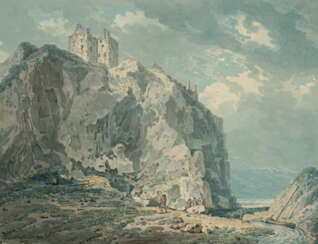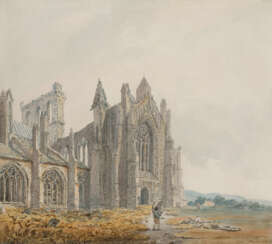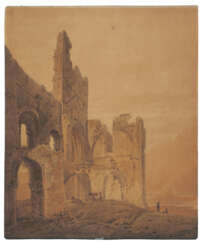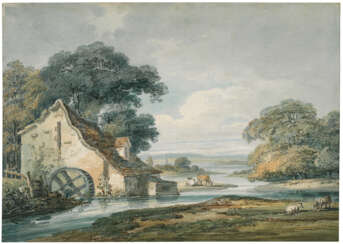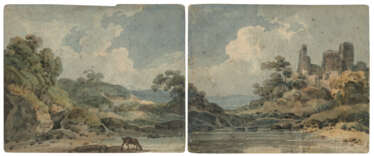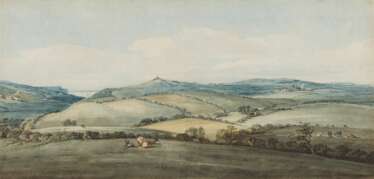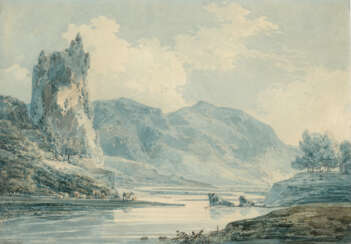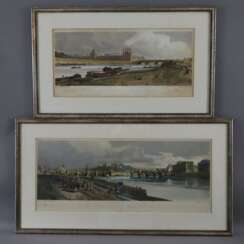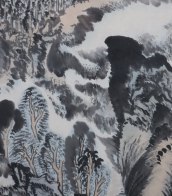thomas girtin (1775 - 1802)
_by_Henry_Edridge.jpg)
Thomas Girtin was a British watercolor painter.
Girtin, along with his artist friend J. M. W. Turner, was the founder of the national school of watercolor. Until the late 18th century, watercolor was mainly used for topographical works such as maps, but thanks to these two artists it became increasingly popular. Girtin developed his bold, spacious, romantic style, which had an indelible influence on English painting.
Girtin created many panoramic watercolor landscapes and views of London and Paris in the Romantic style. His giant panorama of London, Eidometropolis, was exhibited in 1802, shortly before his premature death.
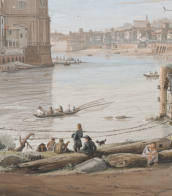
_by_Henry_Edridge.jpg)
Thomas Girtin was a British watercolor painter.
Girtin, along with his artist friend J. M. W. Turner, was the founder of the national school of watercolor. Until the late 18th century, watercolor was mainly used for topographical works such as maps, but thanks to these two artists it became increasingly popular. Girtin developed his bold, spacious, romantic style, which had an indelible influence on English painting.
Girtin created many panoramic watercolor landscapes and views of London and Paris in the Romantic style. His giant panorama of London, Eidometropolis, was exhibited in 1802, shortly before his premature death.

_by_Henry_Edridge.jpg)
Thomas Girtin was a British watercolor painter.
Girtin, along with his artist friend J. M. W. Turner, was the founder of the national school of watercolor. Until the late 18th century, watercolor was mainly used for topographical works such as maps, but thanks to these two artists it became increasingly popular. Girtin developed his bold, spacious, romantic style, which had an indelible influence on English painting.
Girtin created many panoramic watercolor landscapes and views of London and Paris in the Romantic style. His giant panorama of London, Eidometropolis, was exhibited in 1802, shortly before his premature death.

_by_Henry_Edridge.jpg)
Thomas Girtin was a British watercolor painter.
Girtin, along with his artist friend J. M. W. Turner, was the founder of the national school of watercolor. Until the late 18th century, watercolor was mainly used for topographical works such as maps, but thanks to these two artists it became increasingly popular. Girtin developed his bold, spacious, romantic style, which had an indelible influence on English painting.
Girtin created many panoramic watercolor landscapes and views of London and Paris in the Romantic style. His giant panorama of London, Eidometropolis, was exhibited in 1802, shortly before his premature death.
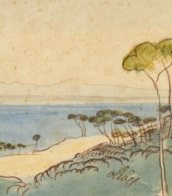
_by_Henry_Edridge.jpg)
Thomas Girtin was a British watercolor painter.
Girtin, along with his artist friend J. M. W. Turner, was the founder of the national school of watercolor. Until the late 18th century, watercolor was mainly used for topographical works such as maps, but thanks to these two artists it became increasingly popular. Girtin developed his bold, spacious, romantic style, which had an indelible influence on English painting.
Girtin created many panoramic watercolor landscapes and views of London and Paris in the Romantic style. His giant panorama of London, Eidometropolis, was exhibited in 1802, shortly before his premature death.

_by_Henry_Edridge.jpg)
Thomas Girtin was a British watercolor painter.
Girtin, along with his artist friend J. M. W. Turner, was the founder of the national school of watercolor. Until the late 18th century, watercolor was mainly used for topographical works such as maps, but thanks to these two artists it became increasingly popular. Girtin developed his bold, spacious, romantic style, which had an indelible influence on English painting.
Girtin created many panoramic watercolor landscapes and views of London and Paris in the Romantic style. His giant panorama of London, Eidometropolis, was exhibited in 1802, shortly before his premature death.

_by_Henry_Edridge.jpg)
Thomas Girtin was a British watercolor painter.
Girtin, along with his artist friend J. M. W. Turner, was the founder of the national school of watercolor. Until the late 18th century, watercolor was mainly used for topographical works such as maps, but thanks to these two artists it became increasingly popular. Girtin developed his bold, spacious, romantic style, which had an indelible influence on English painting.
Girtin created many panoramic watercolor landscapes and views of London and Paris in the Romantic style. His giant panorama of London, Eidometropolis, was exhibited in 1802, shortly before his premature death.
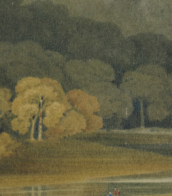
_by_Henry_Edridge.jpg)
Thomas Girtin was a British watercolor painter.
Girtin, along with his artist friend J. M. W. Turner, was the founder of the national school of watercolor. Until the late 18th century, watercolor was mainly used for topographical works such as maps, but thanks to these two artists it became increasingly popular. Girtin developed his bold, spacious, romantic style, which had an indelible influence on English painting.
Girtin created many panoramic watercolor landscapes and views of London and Paris in the Romantic style. His giant panorama of London, Eidometropolis, was exhibited in 1802, shortly before his premature death.

_by_Henry_Edridge.jpg)
Thomas Girtin was a British watercolor painter.
Girtin, along with his artist friend J. M. W. Turner, was the founder of the national school of watercolor. Until the late 18th century, watercolor was mainly used for topographical works such as maps, but thanks to these two artists it became increasingly popular. Girtin developed his bold, spacious, romantic style, which had an indelible influence on English painting.
Girtin created many panoramic watercolor landscapes and views of London and Paris in the Romantic style. His giant panorama of London, Eidometropolis, was exhibited in 1802, shortly before his premature death.
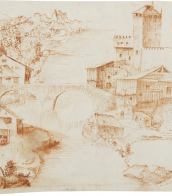

Joseph Mallord William Turner, a seminal figure in British painting, was born in 1775 and left an indelible mark on the Romantic movement. Known for his expressive coloration, imaginative landscapes, and turbulent marine paintings, Turner's work transcends the traditional boundaries of art to capture the sublime force of nature. His career was distinguished by early talent, evidenced by his acceptance into the Royal Academy at the young age of 14, and a prolific output that included over 2,000 paintings and 19,000 drawings and sketches.
William Turner's unique approach to landscape painting, characterized by dramatic skies and atmospheric effects, set a new standard for capturing mood and emotion on canvas. His innovative use of light and color influenced countless artists, elevating landscape painting to rival the status of history painting. Turner's legacy is also marked by his eccentricity and reclusiveness, traits that only added to the mystique surrounding his artistic genius.
Among his most famous works are "The Fighting Temeraire," symbolizing the passing of the old world, and "Rain, Steam and Speed," capturing the Industrial Revolution's impact. These paintings not only showcase William Turner's technical skill but also his philosophical engagement with the changing world around him.
For collectors and experts in art and antiques, William Turner's works represent the pinnacle of Romantic art, offering insight into the 19th-century aesthetic and philosophical landscape. His influence on subsequent generations of artists underscores his position as a pivotal figure in the history of Western art.
To stay informed about Joseph Mallord William Turner's works and related events, signing up for updates from reputable art institutions can provide valuable insights into new discoveries and auction events related to this master of the British landscape.

